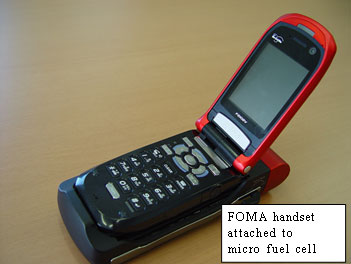3G handsets get prototype fuel cell

The device, manufactured by Fujitsu Laboratories, generates power by combining methanol and hydrogen. DoCoMo claims that development of the cell could be completed by the end of 2005.
"The micro fuel cell is aimed at meeting user demands for more convenient handsets with greater power capacity, as well as reduced environmental impact," said DoCoMo in a statement.
DoCoMo added that it is keen to boost the power available to mobile phone users, as applications such as video-streaming have considerable power demands.
As the picture below shows, the micro fuel cell is shaped like a cradle which the mobile handset can be fitted into for a recharge. It weighs 190g, and generates almost 3.8 Watts of power.
Each methanol cartridge would only provide enough power for one recharge, so users would either have to carry a number of cartridges about their person or hope they could find a shop selling one if necessary.
Fujitsu announced at the start of this year that that it had found a way of using highly concentrated methanol to create fuel cells with up to ten times as much power per unit weight as a conventional lithium-ion battery.
By developing a better membrane, Fujitsu can use a concentration of 30 percent methanol in its fuel cells, compared to rival prototype products that use concentrations of between 10 percent and 25 percent.
The real challenge facing NTT DoCoMo and Fujitsu, and every other company working on fuel cells, is to convert their prototypes into commercial products. For many years the IT industry has been told that fuel cells are just around the corner, and that's where they still are today.
